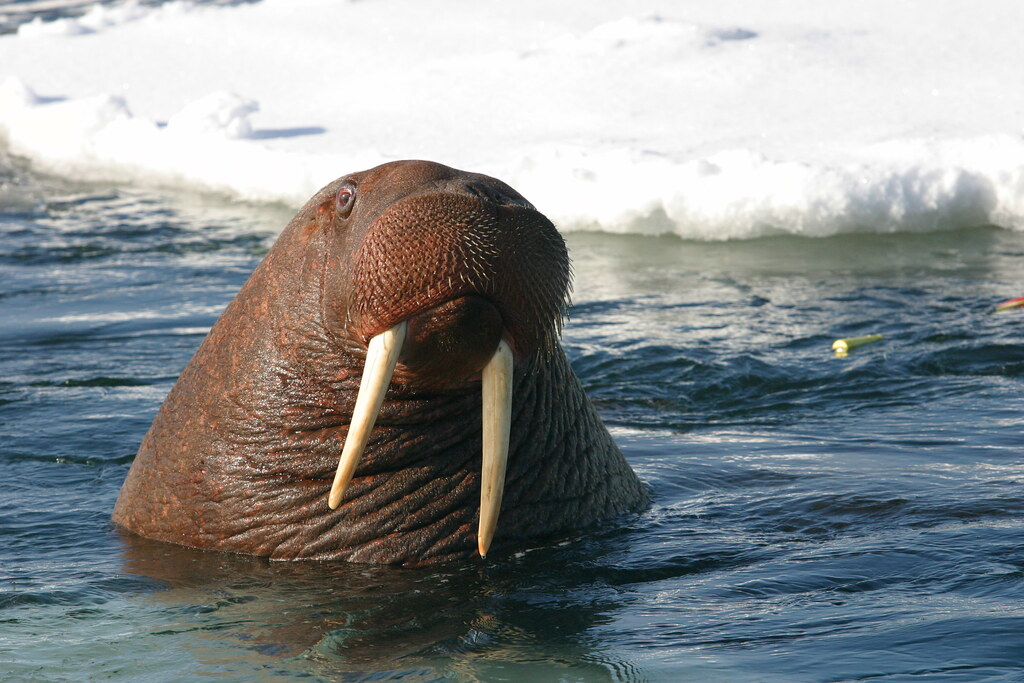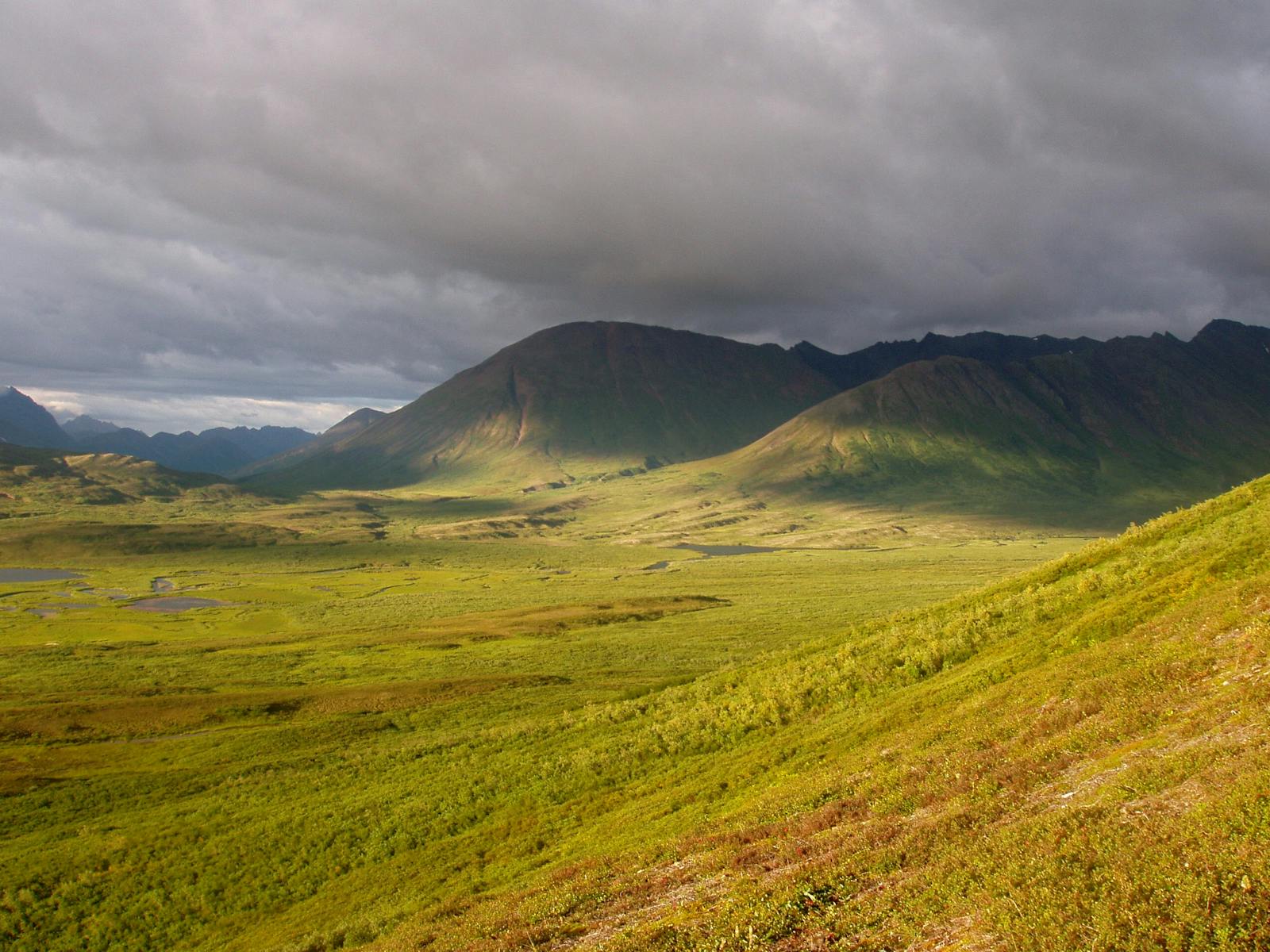Ahklun and Kilbuck Upland Tundra
The ecoregion’s land area is provided in units of 1,000 hectares. The protection goal is the Global Safety Net (GSN1) area for the given ecoregion. The protection level indicates the percentage of the GSN goal that is currently protected on a scale of 0-10.
Bioregion: Greater Alaska Taiga & Tundra (NA4)
Realm: Subarctic America
Ecoregion Size (1000 ha):
5,065
Ecoregion ID:
404
Conservation Target:
98%
Protection Level:
7
States: United States: AK
The Ahklun and Kilbuck Upland Tundra ecoregion consists primarily of the Ahklun and Kilbuck mountain ranges in southwestern Alaska and was formerly considered part of the Beringia Upland Tundra ecoregion. This ecoregion is bounded by the Bering Sea on the south and west (including Bristol, Kuskokwim, and Togiak Bays), by the Beringia Lowland Tundra ecoregion (which it bisects) on the east and west, and by the Interior Alaska-Yukon Lowland Taiga ecoregion on the north.
The Ahklun and Kilbuck Upland Tundra ecoregion consists of steep, sharp groups of rugged mountains separated by broad, flat valleys and lowlands. The mountains were glaciated during the Pleistocene, but only a few small glaciers remain today. This is one of the most pristine ecoregions on the continent, with 99% of its habitat intact—65% within protected areas, including the 16,602 km2 Togiak National Wildlife Refuge, and 34% outside of protected areas.
The climate of this ecoregion has both maritime and continental influences. The average daily minimum temperature in winter is -16ºC and the average winter maximum temperature is -8ºC. In the summer mean daily highs are in the 16ºC to 19ºC range, while mean daily lows are around 8ºC. Average annual precipitation ranges from 1,020 mm in the lowlands to 2,030 mm in the high mountains. The geology of this ecoregion is complex, with strongly deformed sedimentary bedrock of late Paleozoic to Mesozoic age. The mountains are often grouped as rings, with erodible small granitic masses surrounded by more resistant hornfel rocks.

The flagship species of the Ahklun and Kilbuck Upland Tundra ecoregion is the Pacific walrus. Image credit: Alaska Region USFWS, Creative Commons
The vegetation consists largely of moist tundra, alpine tundra, and dwarf scrub thickets. The dwarf scrub communities are dominated by plants in the heath family or by a mix of dwarf Arctic birch and mountain avens. Trees are limited to valley floors and lower slopes and are mainly white spruce, black spruce, paper birch, and balsam poplar. Patches of alder and willow occur above timberline throughout the ecoregion.
Tamarack, quaking aspen, resin birch, and black spruce form the understory of black spruce woodlands, which are mostly confined to the northeastern corner of the ecoregion. Common herbs include twinflower, bluejoint reedgrass, and horsetails interspersed through a heavy cover of feathermosses. Lichens are abundant in open areas.
The coast and islands are mostly rugged, with steep rocky cliffs and promontories. Mammals along the coast include the Pacific walrus, with the Walrus Islands in Togiak Bay supporting Alaska’s largest walrus haulout site. Additional marine mammals include harbor seals, spotted seals, the federally endangered Steller’s sea lion, sea otter, and several species of whales.
Terrestrial mammals include brown bear, black bear, barren-ground caribou, moose, beaver, wolf, wolverine, river otter, lynx, marten, hoary marmot, Arctic ground squirrel, and others. Seabirds nest in the coastal cliffs in large numbers, including common and thick-billed murrres, horned and tufted puffins, black and pigeon guillemots, marbled and Kittlitz’s murrelets, and parakeet and rhinoceros auklets.
.jpg)
Brown bear. Image credit: Alaska Region USFWS, Creative Commons
Shorebirds are abundant in low coastal areas. Steller’s eider and spectacled eider, both federally threatened species, as well as emperor goose, black brant, and five species of loons, use coastal waters seasonally. Both bald eagle and Steller’s sea eagle (the latter rare) are found here.
Notable landbirds include peregrine falcon, gyrfalcon, northern goshawk, three species of ptarmigan, snowy owl, great gray owl, northern hawk owl, boreal owl, northern shrike, boreal chickadee, gray-headed chickadee, Arctic warbler, northern wheatear, yellow wagtail, white wagtail, Harris’ sparrow, golden-crowned sparrow, Lapland longspur, among others. Five species of salmon have strong runs in this ecoregion.
Although this ecoregion is pristine at this time, no place is safe from exploitation given continued growth of the human population and economy. Mining may be the most immediate threat, as several areas in the mountains have high potential for mineral exploitation. Both the Pacific walrus and the Kilbuck caribou herd have suffered periodic declines, likely related in part to over-harvest.
Priority conservation actions for the next decade are: 1) maintain the integrity of protected areas by not allowing incompatible uses; 2) prohibit mining and other intensive human activities throughout the ecoregion; and 3) protect vulnerable wildlife from over-hunting and monitor populations.
Citations
1. Ricketts, T.H. et al. 1999. Terrestrial Ecoregions of North America: A Conservation Assessment. Island Press, Washington, D.C.
2. Gallant, A.L., E.F. Binnian, J.M. Omernik, and M.B. Shasby. 1995. Ecoregions of Alaska. USGS Professional Paper 1567. U.S. Govt. Printing Office, Washington, D.C.
3. Petersen, M.R., D.N. Weir, and M.H. Dick. 1991. Birds of the Kilbuck and Ahklun Mountains Region, Alaska. North American Fauna 76. USDI Fish and Wildlife Service. Anchorage, AK.



